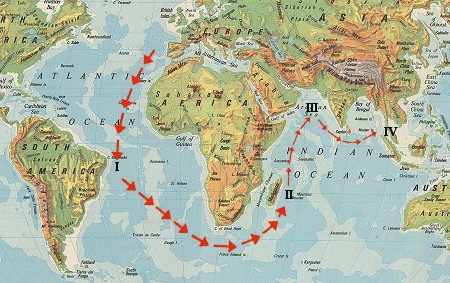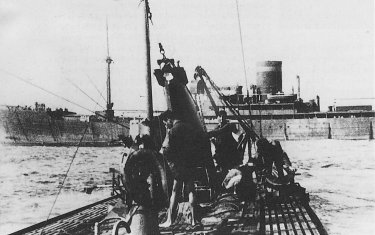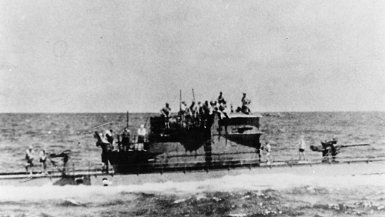

|
U-Boats in the Far East
Gruppe Monsun Boats
After the Italian transport submarines, Gruppe Monsun was the first wave of German U-boats to be dispatched to the Far East. Destined for offensive operations in the Arabian Sea, a group of nine Type IXCs and two Type IXD2s set sail from Europe in mid 1943. Due to necessity, each U-boat was also loaded with special cargo for delivery to Japan, although this had meant reduced effectiveness for the boats at performing dual roles. The limited range of the Type IXCs also meant that the boats had to be refueled during the outbound journey and were to arrive in their operational zones in September 1943, right after the Monsoon season Ė thus the name given to the operating boats.
The refueling difficulties incurred by Gruppe Monsun illustrate just how complicated and hazardous mid-ocean replenishment could be. In the plan, two mid-ocean replenishments were necessary. The first replenishment was scheduled to be conducted by U-462, a Type XIV U-tanker at a location east of St. Paulís Rock, off the Brazilian coast in the South Atlantic. The group would then sail to Mauritius in the Indian Ocean for a second replenishment by a surface tanker. Thereafter, they were to take up offensive operations in the Arabian Sea, before sailing to the U-boat base in Penang for replenishment. From then on, they were to be based in Penang, where they could sortie against Allied shipping in the Indian Ocean.
 |
The original plan for Gruppe Monsun :-
I - 1st refueling point by Type XIV U-462, off the Brazilian coast II - 2nd refueling point by a surface tanker, off Mauritius IIII - Offensive operations in the Arabian Sea IV - Sail to Penang for station in the Far East |
As the group prepared to depart, the U-200 was the first to set sail from Norway on June 11 1943. Barely two weeks later, on June 24, the first hitch occurred when she was sunk with all hands southwest of Iceland while on the way to join the group. The remaining ten boats set sail soon after, and while en route to their first replenishment area in the South Atlantic, three more members of the group were sunk. The U-514, U-506 and U-509 were sunk by aircraft while trying to break through into the Atlantic. This left seven more boats to continue their journey.
The next hitch occurred with the U-847, a long range Type IXD2. In an emergency situation, she was diverted to refuel other boats in the Sargasso Sea. These were the homeward bound boats from the American coast, after they had run out of fuel when their replenishment tankers were sunk. Having completed her mission, she sailed to the southwest of the Azores for yet another emergency refueling operation. This operation however, turned out to be her last as she was sunk by US Navy aircraft on August 27 1943, southwest of the Azores.
Meanwhile, the groupís designated U-tanker, the Type XIV U-462 was seriously damaged by Allied aircraft while crossing the Bay of Biscay. In the planned operation, she was to sail with the pack and refuel the Monsun boats in the South Atlantic. Serious damage however forced the U-462 to return to port for repairs, leaving the Monsun boats without a replenishment tanker. BdU then hastily cobbled together a new replenishment plan, which turned out to be somewhat of a fiasco.
In the revised plan, another Type XIV, the U-487 already at sea was diverted to refuel the Monsun boats at a location some 800 miles south of the Azores. Unfortunately, the U-487 had already replenished eight other U-boats and had insufficient diesel fuel to replenish all of the Monsun boats. As such, another Type IXC in the area, the outward bound U-160 was ordered to rendezvous with the U-487 and to transfer to the tanker all the diesel fuel it required, and then returning to France.
 |
| Mid-ocean replenishment such as this from the supply ship Kormoran to the U-124 were extremely hazardous. Through intercepted messages, the Allies often knew the whereabouts of supply tankers or U-tankers and they were meticulously hunted and destroyed between 1942 and 1943. By June 1944, the entire network of U-tankers had been destroyed. |
A great deal of radio messages had to be sent in order to set up such an arrangement. These messages were intercepted and the Allies learnt all about the arrangement. Thus, on July 13 1943, after taking on fuel from the U-160, the tanker U-487 was attacked by US Navy aircraft from the USS Core. The crew put up a good fight with their AA guns and managed to shoot down one F4F Wildcat. Despite the impressive showdown, the U-487 was sunk with 31 dead. There were 33 survivors.
Unknown to the group that the tanker U-487 had been sunk, Gruppe Monsun arrived at the replenishment zone on July 14 and found the area empty. After scouring for three days, BdU concluded that the tanker had been lost. The U-160 who had topped up the ill-fated tanker was still around, but had already transferred its fuel to the tanker and had insufficient fuel for all the remaining six Monsun boats.
To overcome this, yet another Type IXC in the area, the U-155 was sent to the rescue. Together with the U-160, they both had just enough fuel for the Monsun boats. Then just as the operation swung into action, the U-160 itself went missing. Later records indicate that she was sunk by aircraft on July 14.
With no other boats left in the area, Gruppe Monsun was short of the required fuel it needed to sail to the second replenishment zone. Thus as a last resort, BdU decided to sacrifice one of the Monsun boats itself so that the others may continue onto the second leg of the journey. The unfortunate Monsun boat was U-516 (Tillessen), which was instructed to transfer to the other boats all the fuel it could spare and then return to France.
 |
 |
| The latest Type IXD2 had just entered the battlefield, but they were commandeered by experienced skippers. The U-847, a member of the Monsun Group is diverted as a tanker, and subsequently sunk by aircraft. | Herbert Kuppisch, the man destined to be the commander of the Penang base. But was KIA when his boat (U-847) was sunk southwest of the Azores. |
Only five Monsun boats now remain to proceed to the second replenishment zone. The five remaining boats, U-168, U-183, U-188, U-532 and U-533 proceeded around the Cape to the second rendezvous point and refueled from the surface tanker Brake without incident. The refueling operation took place over September 11 to 13 1943, at a location 450 miles south of Mauritius.
Upon refueling, the Monsun boats sailed for the Arabian Sea where as a group, they sank six ships for 33843 tons and damaged two for 15822 tons for a loss of one of their own. The U-533 was sunk in the Gulf of Aden on October 16 1943. Thereafter, the four remaining boats put to port in Penang, arriving there in October and November 1943, or almost four months after they had set sail from Europe.
In summary of the Gruppe Monsun boats. Of the original eleven boats in the pack; four had been sunk en route, while its designated U-tanker was damaged and had to return to port. In the revised plan, two boats summoned to the rescue were both sunk, while two of the Monsun boats itself had to be diverted for other emergency refueling operations. One of them was sunk in the process and the other was compelled to return to France. All these was a heavy price to pay for just five Type IXCs to be able to operate in the Arabian Sea. The logistic problems faced by Gruppe Monsun demonstrates that distant operations were hardly profitable and why logistic support was such a serious problem for U-boats and their crew. In addition, the steady destruction of the Type XIV Milk Cow U-boat tankers which refueled and replenish the boats at sea made these distant operations even more difficult.
Fate of the Monsun Boats
During the outbound journey, Gruppe Monsun boats sank 6 ships for 33842 tons and damaged 2 ships for 15822 tons. Only three boats in the pack conducted successful attacks.
| Fate of the Gruppe Monsun Boats | |||||
| Boat | Type | Commander | Depart | Fate | |
| U-200 | IXD2 | KL Heinrich Schoder | Norway, Jun 11 1943 | Sunk, Jun 24 1943 | |
| U-514 | IXC | KL Hans-Jurgen Auffermann | France, July 3 1943 | Sunk, Jul 8 1943 | |
| U-509 | IXC | KL Werner Witte | France, Jul 3 1943 | Sunk, Jul 15 1943 | |
| U-506 | IXC | KL Erich Wurdemann | France, Jul 6 1943 | Sunk, Jul 12 1943 | |
| U-847 | IXD2 | KL Herbert Kuppisch | Norway, Jul 29 1943 | Diverted as tanker
Sunk, Aug 27 1943 |
|
| U-516 | IXC | KL Hans-Rutger Tillessen | France, Jul 8 1943 | Diverted as tanker
Aborted to France, Aug 23 1943 |
|
| U-533 | IXC/40 | KL Helmut Hennig | France, Jul 6 1943 | Arrived for operations in the Arabian Sea
Sunk in the Arabian Sea, Oct 16 1943 |
|
| U-188 | IXC/40 | KL Siegfried Ludden | France, Jun 30 1943 | Arrives at Penang, Oct 31 1943 | |
| U-168 | IXC/40 | KL Helmut Pich | France, Jul 3 1943 | Arrives at Penang, Nov 11 1943 | |
| U-532 | IXC/40 | FK Ottoheinrich Junker | France, Jul 3 1943 | Arrives at Penang, Oct 31 1943 | |
| U-183 | IXC/40 | KK Heinrich Schafer | France, Jul 7 1943 | Arrives at Penang, Oct 27 1943 | |
Next: German Transport Boats



